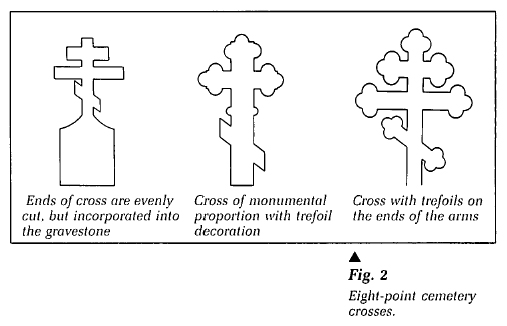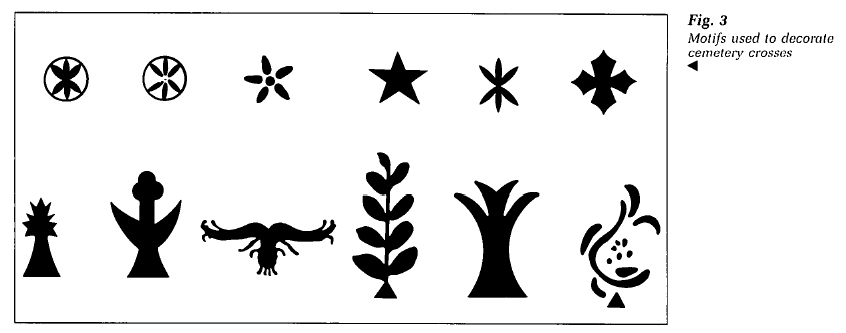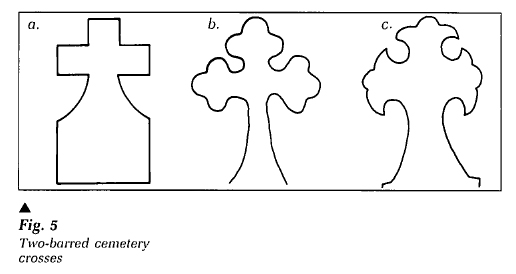Research Reports / Rapports de recherche
Crosses of East Slavic Christianity among Ukrainians in Western Canada
1 Since the Middle Ages the cross has been a tangible and visible symbol of Christian faith and tradition. First appearing in the fourth century,1 the cross developed in various ways among different churches, cultures and nations.2 Two basic forms of the cross—relating to the Latin and Greek traditions in the Christian faith—emerged and are now found in many local variations. Although both Latin and Greek crosses are present in Western and Eastern liturgies,3 they have always been symbols of distinctive ecclesiastical traditions. With the growth of national consciousness, often enhanced by religious concerns, crosses have become symbols of distinctive national identities.
2 For the eastern Slavs (today's Russians, Ukrainians and Byelorussians), the cross originated in Byzantium and was subsequently developed by the Kievan ecclesiastical tradition. It was brought to western Canada by successive waves of immigrants from Ukraine and is materially present in the geographic and cultural landscape of the Prairies. These settlers came mainly from two regions—Galicia and Bukovyna—which were under Austro-Hungarian political domination until 1919. The early Ukrainian immigrants often lacked national consciousness; church membership, Catholic or Orthodox,4 was the main factor of collective identity. Venerated religious symbols, such as the cross, served to heighten national differentiation and distinctiveness.
3 This article analyzes the cross primarily as a material object originating within east Slavic ecclesiastical and folk tradition but created in Canada as a collective symbol of Ukrainian religiosity and nationality. Aesthetic values and other manifold symbolic meanings are not treated here. The article is based on the author's field research conducted in 1986 among selected east Slavic communities in Manitoba, Saskatchewan and Alberta.
Functional Classification
4 Functionally, there are two main groups of crosses in the Ukrainian culture in western Canada: ecclesiastical (having a liturgical or theological function) and folk (having a function based on folk tradition). Ecclesiastical crosses include blessing, processional, standing liturgical, pectoral (of dignitaries) and decorative (printed and embroidered). Folk crosses include cemetery, wall, wayside and commemorative, pectoral (jewellery) and architectural (atop churches or in belfries). This functional classification is based on well-documented historical material from nineteenth-century Ukraine. As a model, it can be used to identify crosses of Eastern Christianity found in western Canada. Only two types of crosses, architectural and cemetery, can be positively identified as created in Canada.
5 To understand any form of religious experience among Ukrainians on the Prairies, it is important to distinguish between church or ecclesiastical art on the one hand, and religious folk art on the other. Historically, the former tradition was cultivated by monastic and eparchial centres, which tenaciously applied Byzantine models and rules when creating objects for liturgical and cult purposes. Icons were their primary expression, but the so-called "minor arts" such as printing and embroidery were based on the same aesthetic principles.5 Distinct from these relatively sophisticated centres of production, folk artists based their work on patterns developed over many generations, individual creativity, foreign models and pre-Christian beliefs.6
6 The history and development of ecclesiastical and religious folk art in the Old World was quite different from that among Ukrainians in western Canada, where no comparable centres of Byzantine tradition took root. Cultural continuity had been disrupted by the Canadian experience; a western-Canadian Ukrainian cultural entity reflected new ties and new settlement patterns. As a result, the two streams in Ukrainian religious art, ecclesiastical and folk, became more thoroughly interwoven and, simultaneously, less differentiated than they were in Ukraine. A popular aesthetic taste based on the memories of only a few generations took the place of a genuine folk tradition.7 The community's religious needs eclipsed the individual creativity of folk artists. In the new environment of western Canada, the significance of the cross as a symbol of group identity was greatly enhanced.
7 Ukrainian cemetery and architectural crosses on the Prairies have three basic forms: the three-barred cross with eight points, the two-barred Latin cross and the two-barred Greek cross. These models have a universal character and are shared by many Christian denominations. No single one of these models is in its character distinctively Ukrainian, but Ukrainian nature is manifested in their formal and symbolic interpretation.
The Three-Barred Cross
8 Sometimes called an Eastern cross,8 the three-barred cross has a special position in Ukrainian religious life. It is composed of a vertical limb and two parallel horizontal arms, plus a third arm in a slanting position. Occasionally, all three horizontal arms are parallel.9 In western Canada, this cross is commonly seen on the top of Orthodox churches and sometimes in Catholic churches and cemeteries. Of 300 Ukrainian Catholic churches in Manitoba and Saskatchewan, only five per cent have the three-barred cross on the roof.10 The most recent Catholic church with a three-barred cross is dated 1944, in keeping with the growing tendency to reserve the three-barred cross for Orthodox structures.11
9 Four types of three-barred crosses are found atop Ukrainian churches and belfries in western Canada (see fig. 1).12 The use of three horizontal bars for wrought-iron church crosses is rare for churches in Ukraine as well as those in western Canada.13 The three-barred cross is typical of Ukrainian wooden blessing crosses and often appeared in prints and on seals.14
10 In cemeteries, the use of three-barred, eight-point crosses in western Canada shows a predilection for three types, as shown in figure 2. The form and proportion of crosses on Ukrainian churches and in cemeteries were strongly influenced by the material used in their production. Church crosses were usually wrought-iron; cemetery crosses were most often stone or cement. The large surfaces on early cemetery crosses were often decorated with sculptured geometric motifs and then painted. The use of colour (black, red, green and orange on a white surface) was characteristic of crosses in the Bukovynian tradition. Stars, palms, crosses, flowers and circles are among the most commonly applied decorations (see fig. 3). Cement crosses were cast in molds with similar motifs.
11 This kind of ornamentation on stone and cement crosses suggests a derivative use of colour and decoration that was originally applied to wooden crosses. One can assume that the first Ukrainian cemetery crosses in western Canada were made of wood, but that most have disappeared from the prairie landscape.15
The Two-Barred Cross
12 Both the Latin and Greek crosses, in spite of their distinctive forms and origins, have been venerated within Western and Eastern churches. The correct proportions for the Latin cross are eight squares high and five squares wide. The Greek cross has seven squares arranged vertically and seven horizontally.16 In Ukraine, the Latin form, a realistic representation of the historic cross, was atop all the oldest churches, whereas the Greek form was largely used for liturgical purposes and rarely as an architectural cross.17 In western Canada, crosses were not designed by architects or artists with a formal aesthetic education, but by local blacksmiths or farmers who did not apply strict rules of proportion. Consequently, it is often impossible to determine whether a given cross is of the Latin type but with a shorter limb, or a Greek type with a longer limb. This uncertainty does not, however, disturb the dominant position of the Latin cross: from among 170 roof crosses in Manitoba, only ten per cent are of the Greek type (fifty per cent are of the Latin type, and forty per cent are three-barred crosses).18
13 Two-barred crosses (including both Latin and Greek forms) found on Ukrainian churches in western Canada may be divided into three groups, as shown in figure 4. The first group shows no special features related to the eastern liturgy or to Ukrainian folk patterns. The cross with the trefoil ends, designed in various ways, has been popular in Ukraine and among Ukrainians in western Canada; it is widely perceived as Ukrainian, in spite of extensive use by Christians of other ethnic origins. A distinctive Ukrainian folk character is present in the third group only (see note 12 on the half-moon element).
14 Two-barred cemetery crosses can be categorized into three groups: crosses with straight bars, having the lower section of the limb incorporated into the gravestone (fig. 5a); crosses with trefoil bars of varying forms and proportions (fig. 5b); and Alisée Patée crosses inscribed within a circle with the three arms curved outward and the lower limb incorporated into the gravestone (fig. 5c). The materials, techniques of production, colours and decorative motifs of these two-barred crosses are the same as those of three-barred crosses.
15 In recent decades, crosses with distinctive Ukrainian features have gradually disappeared from cemeteries on the Prairies. They have been replaced by popular patterns lacking traditional east Slavic characteristics. As symbols of a Ukrainian heritage in western Canada, Ukrainian crosses on the Prairies cannot be fully appreciated without comparison to their antecedents in Ukraine, where they held a position of privilege within the landscape and Ukrainian art.
16 In Ukraine, a harmonious combination of ecclesiastical and folk elements, variety of shapes and richness of decoration distinguished Ukrainian crosses from Polish ones, which often were nearby. In contrast to icons, Ukrainian crosses not only maintained their own character but influenced the neighbouring traditions of Latin, Polish folk art.19
17 Ukrainian crosses from western Canada illustrate a direct continuation of the thousand-year-old tradition of Ukrainian religious art. When compared with examples from Ukraine itself, their aesthetic values and limited variety of form make them less interesting to an art historian or museum curator. However, their significance as collective symbols of a distinctive group identity is even stronger and possibly more important in Canada than it was in Ukraine.
This article was made possible by a grant from Multiculturalism Canada.




